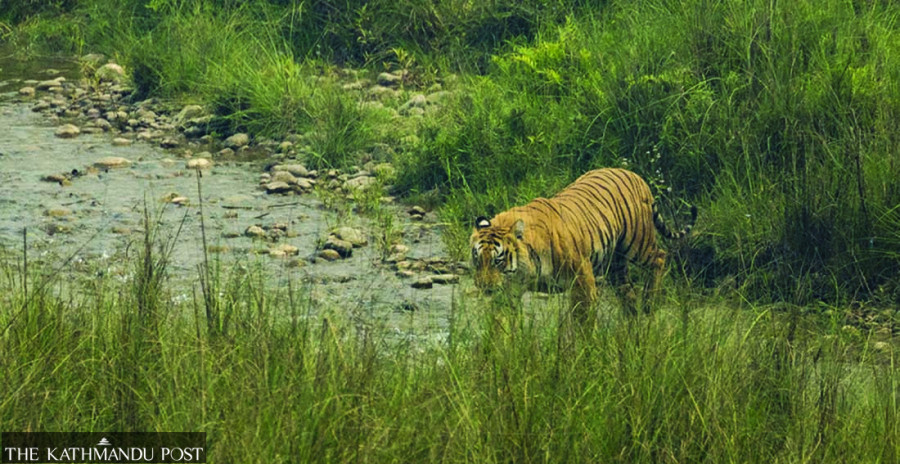National
Bardiya National Park wins TX2 Award for tiger conservation
The latest tiger census report released in 2018 put the number of big cats in the country at 235, which is nearly double of the 121 tigers recorded in 2009.
Anup Ojha
Nepal’s Bardiya National Park and India’s Sathyamangalam Tiger Reserve have jointly won this year’s TX2 Award on Tuesday for doubling their tiger populations since 2010.
TX2, which is one of the most ambitious conservation goals ever set for a single species and the second Global Tiger Summit in Russia’s Vladivostok in September 2022, offers the opportunity to set a new vision to secure the animal’s future.
The Bardiya National Park in Nepal is the largest national park in the lowland Terai that covers an area of 968 sq km and is a home to the endangered Royal Bengal tiger. The park has also earned accolades for posting an impressive growth in tiger population by almost five-fold from less than 20 tigers in 2009 to 87 in 2018, when a nationwide tiger census was conducted.
Park authorities say the number of tigers at the park has increased because of suitable natural habitats, availability of prey and improved security situations.
Earlier in 2019, the park was awarded under the best Sustainable Destination in the “Asia-Pacific” category of the Sustainable Top 100 Destination Award-2019.
According to the park’s records, in the fiscal year 2021/22 (2077/78 BS) 12 people were killed in the park area. Bishnu Prasad Shrestha, warden of the park, said of the total death seven were outside the buffer zone.
Meanwhile, in four years up to the fiscal year 2019-20, six people were killed and 12 others were injured in tiger attacks in Bardiya.
“The TX2 Award is a global recognition of our combined efforts and an outcome of our team work by park staff, Nepal Army, local community and all the stakeholders,” said warden Shrestha on the phone.
“The park has made a five-year action plan to reduce human-tiger conflict, and now we are more focused on resolving the conflict although it's a challenging one,” he added.
The latest tiger census report released in 2018 put the number of big cats in the country at 235, which is nearly double of the recorded 121 tigers in 2009.
However, in recent times a new trend of tigers being sighted in high hills in the northern Nepal has surprised many wildlife experts. It is learnt that improved green cover, less disturbance in the uplands compared to the Tarai, habitat loss and decline in prey have been attributed for the new phenomenon.
As per its commitment to the Global Tiger Recovery Plan (TX2), which was endorsed by 13 countries that are home to wild tigers, during the 2010 St Petersburg Declaration on Tiger Conservation, Nepal has been working to double its tiger population to 250 or more by 2022 from its base tiger population of around 125 in 2010.
The awards are presented by the Conservation Assured Tiger Standards (CA|TS), Fauna and Flora International (FFI), Global Tiger Forum (GTF), IUCN’s Integrated Tiger Habitat Conservation Programme (ITHCP), Panthera, UNDP, The Lion’s Share, Wildlife Conservation Society (WCS) and WWF. And that acknowledges the efforts by the state government and the local communities for playing their vital role to preserve tiger reserves into one of the source populations of tigers in Nepal and India.
In recent times, the BNP has become a tourist hotspot courtesy of the Royal Bengal tigers.
The co-winner of the TX2 Award, India’s Sathyamangalam Tiger Reserve is located in Tamil Nadu state. Sathyamangalam was designated a Tiger Reserve in 2013, was home to only 25 tigers in 2011 but today there are an estimated 80 individuals in the area.
Meanwhile, the associated second award for Tiger Conservation Excellence is to be presented to the incredible transboundary Khata corridor where community based conservation efforts, including a network of 74 community forests covering 202 sq km, have secured safe passage for tigers between Bardiya National Park in Nepal and Katarniaghat Wildlife Sanctuary in India, according to a statement by the World Wide Fund for Nature (WWF). Over the last five years, 46 individual tigers have been detected using the corridor with other iconic and threatened mammal species, including the Asian elephant and the greater one-horned rhino.
The WWF statement said the awards celebrate the upcoming launch of the 2022 Lunar Year of the Tiger.
In September tiger range countries will convene at the second Global Tiger Summit in Vladivostok, Russia, to assess progress towards the ambitious TX2 goal, that is to double the number of tigers in the wild - and to identify tiger conservation priorities for the next 12 years.




 13.12°C Kathmandu
13.12°C Kathmandu.jpg)















